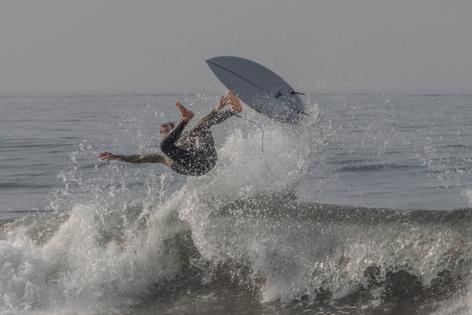Surfboard lights might deter shark attacks -- but don't bet your life on it
Published in Lifestyles
LOS ANGELES — Australian researchers, who spent years towing seal-shaped decoys through waters infested with great white sharks, have determined that wrapping the lures in very bright lights — sort of like aquatic Christmas trees — seems to turn sharks away.
That's because, from below, sharks are accustomed to seeing the dark silhouettes of their prey backlighted by the sun.
So wrapping the body of a fake seal in bright, horizontally striped LED lights seems to break the silhouette into smaller pieces that no longer look like a seal, said researcher Nathan Hart, head of the School of Natural Sciences at Macquarie University in Sydney.
Hart and one of his co-authors on a study recently published in Current Biology, biologist Laura Ryan, are planning to install similarly patterned LED lights on the bottoms of surfboards to see whether that can help reduce the risk of shark attacks.
"Surfing for me is a really peaceful place. It's about being in nature; it's about doing something I love," Ryan said. She's hoping the technology might help make it just a little more peaceful.
This is not the first time scientists have looked for a technological fix for a threat that, although incredibly rare, still plays in a loop — like the ominous theme from "Jaws" — in the back of many oceangoers' minds.
Previous researchers have tried using devices that emit electromagnetic fields to disrupt sharks' electroreceptors. Others have tried bracelets that emit smells that sharks, theoretically, would find repulsive. Still others have marketed black-and-white striped wetsuits based on a theory similar to that behind the LED lights: disrupting the prey-like silhouette.
But for decades, the data on all such shark repellents have been "ambiguous," said Chris Lowe, a marine biologist and director of the Shark Lab at Cal State Long Beach, who had not read the new Australian study.
The previous devices seemed to work about 40% to 50% of the time. "If your goal is to feel more confident in the water, and you can afford it, great," Lowe said.
But he worries that some people put these things on and feel invincible, like they're wearing "Superman's cape." And then they go surfing in places where sharks normally feed, putting themselves at much higher risk.
"I always put the old birth control litmus test to it," Lowe said. "Would you be satisfied with a birth control device that only worked 40% of the time?"
One of the problems with devices designed to make people essentially invisible to sharks is that eyesight isn't the only tool they use to detect prey: They also use their sense of smell and their ability to detect vibrations in the water.
"How important is it that a shark can't see you if it can still smell you and feel you," Lowe asked.
Whatever sensory input sharks use to track us down, the truth is, they're not that interested in humans. Since 2000, millions of people have splashed around in the waters off the California coast, but there have been only 127 shark incidents recorded by the state Department of Fish and Wildlife. An "incident" is when someone is approached and touched by a shark, or the shark touches their surfboard, paddleboard or similar mode of transport.
Although it's safe to assume everyone who experienced such an incident was well and truly freaked out, only 51 reported a physical injury. And only eight people were killed by the shark. At least seven of those deaths were caused by great whites; in the other case, the species is unknown.
You have a better chance of being killed by lightning.
To conduct their six-year study, the Australian scientists traveled to Seal Island off the coast of South Africa, the setting for countless "Shark Week" episodes and YouTube videos celebrating the sheer spectacle, and jaw-dropping violence, of great whites rocketing up from the depths and breaching the surface with doomed seals clutched in their mighty jaws.
Through the course of their research, the team learned that the arrangement and intensity of the lighting is critical. If strung vertically, along the length of the fake seal's body, the lights don't do enough to disrupt the silhouette visible from below. And the lights need to shine brightly enough to counteract the effect of the sun shining from above.
For optimal "counterillumination," the scientists found, the artificial light has to be brighter than the background light.
"If you don't get this right, it might not have the effect," Hart said.
©2024 Los Angeles Times. Visit at latimes.com. Distributed by Tribune Content Agency, LLC.
























Comments